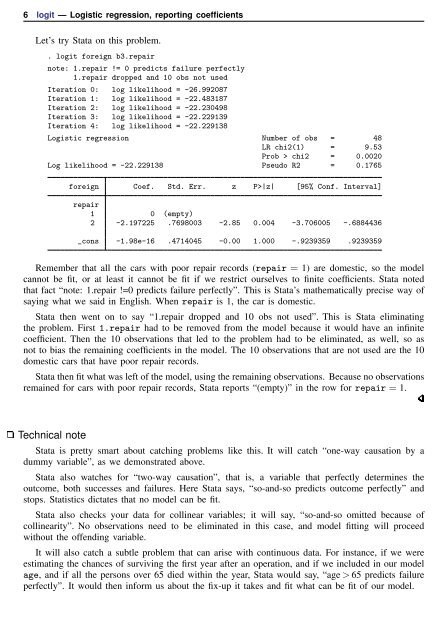logit - Stata
logit - Stata
logit - Stata
Create successful ePaper yourself
Turn your PDF publications into a flip-book with our unique Google optimized e-Paper software.
6 <strong>logit</strong> — Logistic regression, reporting coefficients<br />
Let’s try <strong>Stata</strong> on this problem.<br />
. <strong>logit</strong> foreign b3.repair<br />
note: 1.repair != 0 predicts failure perfectly<br />
1.repair dropped and 10 obs not used<br />
Iteration 0: log likelihood = -26.992087<br />
Iteration 1: log likelihood = -22.483187<br />
Iteration 2: log likelihood = -22.230498<br />
Iteration 3: log likelihood = -22.229139<br />
Iteration 4: log likelihood = -22.229138<br />
Logistic regression Number of obs = 48<br />
LR chi2(1) = 9.53<br />
Prob > chi2 = 0.0020<br />
Log likelihood = -22.229138 Pseudo R2 = 0.1765<br />
foreign Coef. Std. Err. z P>|z| [95% Conf. Interval]<br />
repair<br />
1 0 (empty)<br />
2 -2.197225 .7698003 -2.85 0.004 -3.706005 -.6884436<br />
_cons -1.98e-16 .4714045 -0.00 1.000 -.9239359 .9239359<br />
Remember that all the cars with poor repair records (repair = 1) are domestic, so the model<br />
cannot be fit, or at least it cannot be fit if we restrict ourselves to finite coefficients. <strong>Stata</strong> noted<br />
that fact “note: 1.repair !=0 predicts failure perfectly”. This is <strong>Stata</strong>’s mathematically precise way of<br />
saying what we said in English. When repair is 1, the car is domestic.<br />
<strong>Stata</strong> then went on to say “1.repair dropped and 10 obs not used”. This is <strong>Stata</strong> eliminating<br />
the problem. First 1.repair had to be removed from the model because it would have an infinite<br />
coefficient. Then the 10 observations that led to the problem had to be eliminated, as well, so as<br />
not to bias the remaining coefficients in the model. The 10 observations that are not used are the 10<br />
domestic cars that have poor repair records.<br />
<strong>Stata</strong> then fit what was left of the model, using the remaining observations. Because no observations<br />
remained for cars with poor repair records, <strong>Stata</strong> reports “(empty)” in the row for repair = 1.<br />
Technical note<br />
<strong>Stata</strong> is pretty smart about catching problems like this. It will catch “one-way causation by a<br />
dummy variable”, as we demonstrated above.<br />
<strong>Stata</strong> also watches for “two-way causation”, that is, a variable that perfectly determines the<br />
outcome, both successes and failures. Here <strong>Stata</strong> says, “so-and-so predicts outcome perfectly” and<br />
stops. Statistics dictates that no model can be fit.<br />
<strong>Stata</strong> also checks your data for collinear variables; it will say, “so-and-so omitted because of<br />
collinearity”. No observations need to be eliminated in this case, and model fitting will proceed<br />
without the offending variable.<br />
It will also catch a subtle problem that can arise with continuous data. For instance, if we were<br />
estimating the chances of surviving the first year after an operation, and if we included in our model<br />
age, and if all the persons over 65 died within the year, <strong>Stata</strong> would say, “age > 65 predicts failure<br />
perfectly”. It would then inform us about the fix-up it takes and fit what can be fit of our model.
















